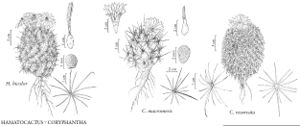Difference between revisions of "Hamatocactus bicolor"
Contr. Gray Herb. 70: 88. 1924.
FNA>Volume Importer |
FNA>Volume Importer |
Revision as of 22:23, 16 December 2019
Spines: central spine yellowish, becoming ashy gray or reddish brown, 1–3.8 cm, minutely scabrous (use 30× lens). Flowers yellow with red centers, leaving obvious, concave abscission scars after fall of flower or fruit; proximal outer tepals obtuse or with broad ± auriculate distal portions; distal ones minutely fringed, acute; inner tepals oblanceolate; filaments reddish, pale yellow, or whitish, collectively spiraled around style; ovary 8–13 mm diam. Fruits displaced away from stem apex by apical growth subsequent to flowering. 2n = 22.
Phenology: Flowering spring–early fall.
Habitat: Grasslands, shrublands, especially mesquite thickets, heavy soils
Elevation: 0-300 m
Distribution

Tex., Mexico (Coahuila, Nuevo León, Tamaulipas).
Discussion
Hamatocactus bicolor is taxonomically isolated in the flora. It is perhaps most similar to Thelocactus bicolor, but H. bicolor is dramatically different in its juicy, scarlet fruits, yellow flowers, very narrowly and sharply ribbed stem surface, and hooked central spines. Hamatocactus bicolor is superficially similar to Ferocactus hamatacanthus var. sinuatus, which is larger and green-fruited with pitted seed coat and much larger yellow flowers lacking red centers. Glandulicactus uncinatus has hooked radial spines, rounded birbs, and small, maroon flowers.
Selected References
None.
